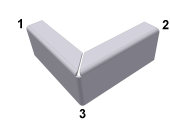 |
Use the Corner Seam command to add a seam between two sheet metal faces. |
|
|
|
Optionally, while the Corner Seam dialog box is displayed you can:
- Elect to use the Face/Edge distance measurement method rather than the defaulted Maximum Gap Distance method.
- Specify a percentage overlap value if you have elected to use a corner seam type of: Overlap, or Reverse Overlap.
- Specify a gap value that differs from the Thickness parameter.
- Alter the bend transition behavior from what is specified in the active style.
- Alter the corner relief (shape or size) from what is specified in the active style.
Three-bend corners

In most situations, use Auto-Miter on the Corner tab of the Flange or Contour Flange dialog box to create three-bend corners. Three-bend corners can also be created using the Corner Seam feature by following these steps:
- Create two nonintersecting flanges. Tip One flange is likely to be an offset flange.
- On the ribbon, click
Sheet Metal tab
 Modify panel
Modify panel
 Corner Seam
.
Corner Seam
. - Select the edge on each flange closest to the appropriate mitered corner as shown.
- For Gap, accept the default Thickness as specified in the current sheet metal style or enter a different value.
Optionally, select Measure, Show Dimensions, or List Parameters to enter a value.
- Click OK to create the corner and close the dialog box.
Note: The corner relief type and radius size specified in the corner tab of the feature is applied when you create your flat pattern and does not display in the folded model.
 Show Me how to use auto-mitering on three bend corners
Show Me how to use auto-mitering on three bend corners